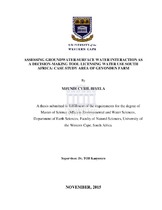| dc.contributor.advisor | Kanyerere, T. | |
| dc.contributor.author | Biyela, Mfundi Cyril | |
| dc.date.accessioned | 2017-03-22T10:04:29Z | |
| dc.date.available | 2017-03-22T10:04:29Z | |
| dc.date.issued | 2015 | |
| dc.identifier.uri | http://hdl.handle.net/11394/5409 | |
| dc.description | >Magister Scientiae - MSc | en_US |
| dc.description.abstract | Assessing groundwater-surface water interaction as a decision-making tool licensing water use South Africa: Case study area of Gevonden Farm is the title of the current study with the context that arises from the use of GRAII methodology which uses quaternary catchment boundaries for groundwater abstraction water use licence application assessment during decision making. The problem is that the quaternary catchment scale approach does not provide the scientific bases for site specific scale. The current study argues that such approach provides realistic, practical information at site specific scale and therefore informs the issuing of licences more accurately. The aim of the current study is to improve understanding of how the assessment of groundwater abstraction water use licence should be carried out at a site specific scale to improve decision making during licence issuance. The objective of the study is to outline the scientific study and
demonstrate how the investigation that leads to the decision making can be conducted. The study was carried out using hydraulic methods such as pumping test and geochemical analysis method. Hydraulic properties were determined and chemical elements were analysed for and compared with the SANS 241 water quality standards for domestic and agricultural use. Hydraulic properties such as hydraulic conductivity (K), transmissivity (T), yield and storativity (S) were
determined. Major and minor ions that are required to be analysed for domestic and agricultural water use were analysed. Piper diagrams and FC method were used to analyse data. The piper diagrams plotted indicated that surface water is mixing with groundwater and that means there is connection between groundwater and surface water. The chemical elements analysed for were compared with SANS 241 water quality standards for domestic and agricultural use. The water quality on the investigated site can be categorized as having good water quality. A sustainable yield estimated from the two boreholes (BH03 and BH05) which
was 1.02 Ɩ/s. The available drawdown estimated with reference to the boreholes water strikes that were determined by EC profiling were 135 mbgl from both boreholes. The study recommends the issuance of water use licence with conditions that chemistry of water should be analysed for once a quarter and boreholes water levels should be analysed for once a month. | en_US |
| dc.language.iso | en | en_US |
| dc.publisher | University of the Western Cape | en_US |
| dc.subject | Groundwater | en_US |
| dc.subject | Groundwater abstraction water use licence | en_US |
| dc.subject | Water use licence applications | en_US |
| dc.subject | Geochemical analysis | en_US |
| dc.subject | South Africa | en_US |
| dc.title | Assessing groundwater-surface water interaction as a decision-making tool licensing water use South Africa : case study area of Gevonden farm | en_US |
| dc.rights.holder | University of the Western Cape | en_US |

